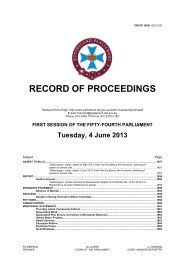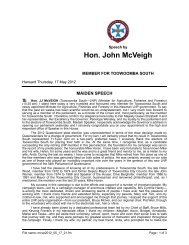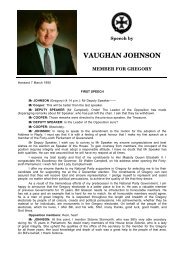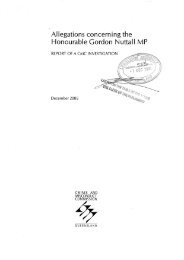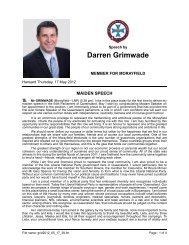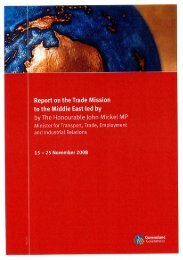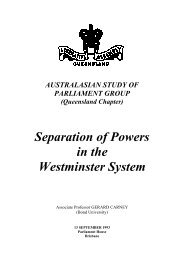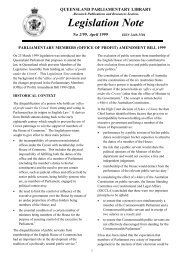weekly hansard - Queensland Parliament - Queensland Government
weekly hansard - Queensland Parliament - Queensland Government
weekly hansard - Queensland Parliament - Queensland Government
You also want an ePaper? Increase the reach of your titles
YUMPU automatically turns print PDFs into web optimized ePapers that Google loves.
23 Aug 2005 Plumbing and Drainage and Other Legislation Amendment Bill 2611<br />
PLUMBING AND DRAINAGE AND OTHER LEGISLATION AMENDMENT BILL<br />
Second Reading<br />
Resumed from 9 August 2005 (see p. 2206).<br />
Mr MALONE (Mirani—NPA) (5.02 pm): It is with some pleasure that I rise to speak on the<br />
Plumbing and Drainage and Other Legislation Amendment Bill 2005. This bill is a step in the right<br />
direction. I would contend that it is probably not a big enough step, but it certainly moves the legislation<br />
in the direction in which it must go in the next few years.<br />
As the Premier said in this House this morning, <strong>Queensland</strong> is probably facing one of its driest<br />
periods in 100 years. The requirement for householders to save water is becoming urgent. Indeed, the<br />
sustainability of cities on the <strong>Queensland</strong> coast remains in doubt while we are unable to supply a<br />
sustainable water supply.<br />
One of the ways in which we can overcome that is with this type of legislation. However, the<br />
opposition contends that it probably does not go far enough. We should also consider issues such as a<br />
subsidy on rainwater tanks, et cetera, which can actually have a big impact and allow our cities to supply<br />
their own water to a certain extent.<br />
The primary reason for the bill is to provide a legislative framework for the use of household grey<br />
water to water gardens in sewered areas. Previously, all grey water generated in sewered areas had to<br />
be discharged into a sewer. That has been the case for a long time. As I said, the drought conditions<br />
across <strong>Queensland</strong> have generated a great deal of interest in other options for water conservation and<br />
reuse. The grey water provisions in this bill provide a framework for the use of grey water in urban<br />
settings, with sensible constraints that manage any potential public health and environmental impacts.<br />
The objectives of the bill are achieved by the amendment of a number of existing approval,<br />
enforcement and offence provisions to include provisions for on-site sewerage facilities, and the<br />
introduction of a new provision which allows local governments to approve grey water use systems in<br />
sewered areas. It is important that local governments control this. I would contend that some of the<br />
enforcement provisions are a bit over the top. For example, once enforcement officers gain access to a<br />
property they have extended powers. We are seeing more and more of this written into the legislation of<br />
this government. However, in the context of this bill, I do not see a real problem with it but from the point<br />
of view of local government it puts an extra onus on their obligations to the general community.<br />
The bill includes the introduction of new provisions, including offence provisions to place sensible<br />
constraints on the use of grey water and to manage potential impacts on public health and the<br />
environment. It amends the PDA to address and clarify some issues, including providing investigative<br />
and disciplinary powers for the Plumbers and Drainers Board to investigate complaints against<br />
plumbers, clarifying some definitions and addressing other minor legislative matters. It amends the<br />
Water Act so that it is not illegal to use grey water to irrigate garden and sewered areas. It also amends<br />
the Local <strong>Government</strong> Act so that it is clear that all fees charged under the PDA are regulatory fees and<br />
must only cover the cost to the local government of providing the service.<br />
I would like to speak briefly on some of the provisos and the reason for the legislation. I think most<br />
members of parliament would be well aware of them. By way of background, it has been reported that<br />
Australians consume more water than any other people across the world. Indeed, for example, in May<br />
2005, the Brisbane City Council estimated that Brisbane residents and businesses drew around<br />
525 million litres of water daily from the Wivenhoe, Somerset and North Pine dams. The extent of this<br />
usage will soon present a problem for <strong>Queensland</strong> because its annual rainfall is about 10 per cent<br />
lower—and that is probably a conservative estimate—than 30 years ago.<br />
Adding to the problem is the fact that around 40 per cent of good quality drinking water is used on<br />
the garden rather than for drinking. Significant population growth in recent years has added a new<br />
pressure. Brisbane residents and <strong>Queensland</strong>ers in a number of regional areas are already facing water<br />
restrictions. Obviously, that is happening right across the state.<br />
In regional centres there has been a history of poor rainfall in recent years and a subsequent fall<br />
in dam water levels. Again, that has been highlighted in parliament today. In general, there has been a<br />
renewed interest in recycling, rainwater tanks and the reuse of grey water for irrigating gardens. The<br />
issue is very topical. Indeed, the opposition supports the legislation wholeheartedly. However, it would<br />
like further incentives put in place to allow for support of people who wish to do this. As most members<br />
realise, to retrofit a system which allows the use of grey water to a greater extent in established homes<br />
would be almost impossible and the cost would be unmanageable. The only way that this legislation will<br />
have any great impact is in new homes, where it is estimated that it will probably cost around $1,600 to<br />
$2,000 to fit the system.<br />
What we are talking about is a system that will probably only be used in homes being built and<br />
possibly homes with suspended floors such as two-storey houses or high blocked houses. It would be<br />
almost impossible to do for houses built on a pad. They would have to destroy some of the flooring to



